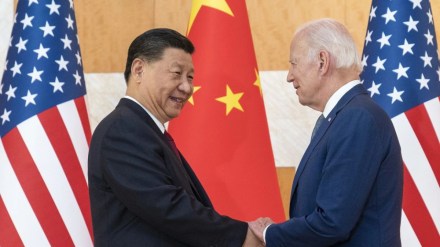In a pivotal moment for international relations, Presidents Biden and Xi recently engaged in a dialogue that left global observers eager to decipher the nuances of their discussions. The Asia Society has provided a detailed analysis of the meeting’s outcomes and the implications for the intricate US-China relationship– covering diverse aspects ranging from economic stability and international investor confidence to climate cooperation, India’s role, and key takeaways for the US business community.
Daniel Russel’s Evaluation:
Daniel Russel, Vice President of International Security and Diplomacy at the Asia Society Policy Institute, asserts that the meeting signifies a mutual desire to reduce risk in the relationship and concentrate on domestic challenges. Xi Jinping’s dual mission, according to Russel, involves stabilizing US.-China relations and restoring investor confidence in China’s economy. However, he cautions that tangible actions are necessary to rebuild business confidence, as risks and restrictions persist.
Despite acknowledging persistent friction, Russel highlights positive shifts in tone and signals of cooperation on reopening military dialogues and regulating artificial intelligence. While the outcomes might be reversible, he emphasizes that direct communication helps prevent dangerous misunderstandings in the intricate dance between the two nations.
Rorry Daniels’ Nuanced Perspective:
He is Managing Director at the Asia Society Policy Institute, and views the summit as lacking major breakthroughs but fostering promising consensus. The leaders, Daniels notes, seem committed to outlining the benefits of responsible management for both nations and the world. The focus on diplomacy and dialogue to manage competitive aspects and address shared issues marks a significant shift in tone.
Daniels emphasizes that the chosen areas of dialogue, particularly tackling the fentanyl crisis and military-to-military discussions, have the potential to demonstrate the benefits of cooperation. While outcomes primarily involve agreements to keep talking, Daniels points out President Biden’s assurance that the leaders can contact each other anytime, underscoring the importance of personal communication in smoothing out inevitable bumps.
Orville Schell’s Observations:
Orville Schell, the Arthur Ross Director at the Asia Society Center on US.-China Relations, notes Xi Jinping’s relatively chastened posture, influenced by economic challenges. Collaboration on climate change, fentanyl control, and military relations, while positive, does not necessarily signal a fundamental shift in the often-hostile US.-China relationship. Schell advocates a cautious approach, emphasizing the need to observe how these developments unfold.
Schell’s perspective raises the question of whether economic circumstances are driving a momentary detente or if they will indeed lead to a more enduring change in the dynamics between the two nations.
Dr. Bates Gill’s Insightful Analysis:
As Executive Director at the Asia Society Policy Institute Center for China Analysis, provides a detailed review of the bilateral meeting’s key points. He highlights a less conciliatory tone in the White House statement, pointing out the absence of formal reassurances given by the US. side. This signals a perceived position of strength from the US., landing many of the takeaways they sought, including anti-drug cooperation and military dialogues.
However, Gill underscores that fundamental differences persist, noting that the two sides remain far apart on principles to moderate and govern their contentious relationship. This nuanced analysis sheds light on the delicate balance between cooperation and divergence in US.-China relations.
Kate Logan’s Climate Cooperation Analysis:
The Associate Director of Climate at the Asia Society Policy Institute, finds optimism in the Sunnylands Statement released by the respective US. and China climate envoys ahead of the Biden-Xi meeting. She views it as a welcome step toward restoring climate cooperation between the world’s two largest emitters, especially after a period of geopolitical tensions sidelining joint action.
While Logan acknowledges the progress made in addressing critical gaps, she points out areas like climate finance, phasing down fossil fuels, and expected emissions reductions that require further attention. This detailed analysis underscores the importance of climate cooperation as a potential stabilizing factor in the broader US.-China relationship.
Farwa Aamer’s Regional Implications:
Director of South Asian Initiatives at the Asia Society Policy Institute, positions the meeting as a pivotal moment in a relationship marked by periods of stagnation and deterioration. She highlights the leaders’ commitment to transparent communication, stressing that turning their backs on each other is not an option. Aamer suggests that India, recognizing its potential to reshape the geopolitical landscape, should meticulously observe the trajectory of US.-China relations.
Aamer notes that the shared desire for joint efforts between the US. and China on issues like climate change and AI might create strategic openings for India to navigate its own interests adeptly. This regional perspective adds another layer to the complex dynamics at play in the aftermath of the Biden-Xi meeting.
Lynette H. Ong’s Economic Assurance Focus:
The Senior Fellow on Chinese Society at the Asia Society Policy Institute Center for China Analysis, sheds light on Xi Jinping’s priority during the trip. She emphasizes Xi’s goal of sending a strong message to the US. business community that China is worth investing in, especially considering declining economic growth and foreign direct investment (FDI) outflows.
Ong delves into the challenges facing Xi, including increased investment risks and the need to assure the US businesses of the safety of their capital and employees. This economic perspective provides a crucial dimension to the broader diplomatic and geopolitical considerations surrounding the Biden-Xi meeting.
